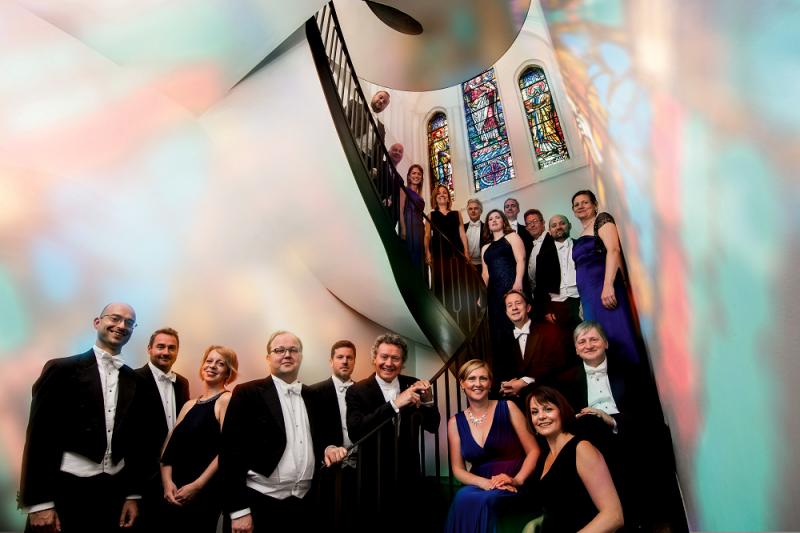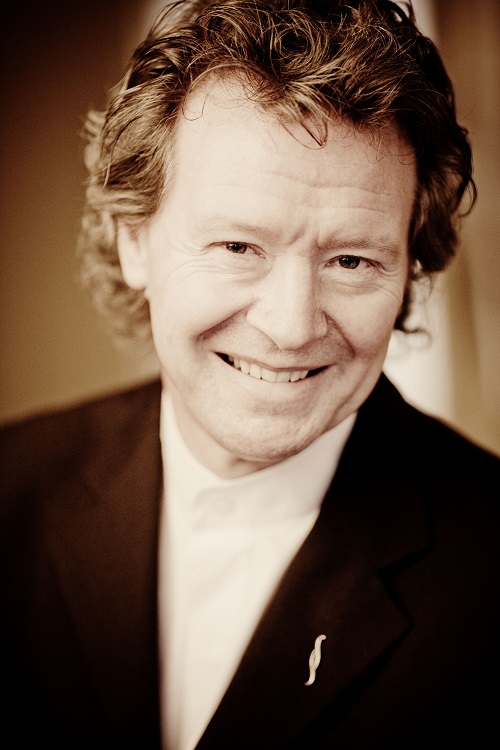Monteverdi Vespers, The Sixteen, Christophers, Cadogan Hall review – majesty on a modest scale | reviews, news & interviews
Monteverdi Vespers, The Sixteen, Christophers, Cadogan Hall review – majesty on a modest scale
Monteverdi Vespers, The Sixteen, Christophers, Cadogan Hall review – majesty on a modest scale
Well-established team brings a passion for clarity and colour

The Monteverdi Vespers are usually a grand affair, but Harry Christophers showed they can work just as well on a smaller scale. Cadogan Hall has a dry acoustic, at least compared to St Mark’s Basilica, so there is little opportunity for billowing waves of choral declamation, echoing through the galleries.
Christophers (pictured below by Marco Borggreve) always adds spectacle. Without a podium, he was free to wander around the front of the stage, leaning deeply into the continuo section, or waltzing across to some distant instrumental soloist, to offer their cue in person. It can be a distracting performance, but there is no denying his close and sensitive communication with the singers. His extravagant arm gestures are usually about articulation and phrasing in the choral writing, and the sheer impact of the tutti numbers is always aided by the crisp, precise consonants he draws from the singers.
The Orchestra of The Sixteen was here a one-to-a-part ensemble, dominated in many of the choruses by the three cornetts and three trombones, but elsewhere given lightness and grace by the pair of recorders. In fact, for most of the work, the chorus or vocal soloists are accompanied just by continuo – usually led by cello or theorbo, supported by violone, dulcian, harp and chamber organ, the latter subtly amplified – and this group was solid throughout, a stable bass over which Monteverdi’s elaborate melodies could flourish.
 For solo numbers and small ensembles, Christophers only directed as necessary. For the motet Nigra sum, theorbo and tenor (Mark Dobell – the busiest soloist here) came to the front of the stage, and for five minutes we were in pure Dowland territory. Similarly, in the following motet, Pulchra es, sopranos Katy Hill and Charlotte Mobbs came to the fore, though this time accompanied by the continuo group in situ. Surprisingly, though, there was little in the way of antiphonal arrangement in the choral numbers, and most of the vocal solos were organised by having the singers rearrange themselves within the choir so as to have the soloists standing adjacent. But two numbers in the second half demanded more dramatic treatment, the Audi coelum and the Glorio patri of the final Magnificat, and for both the two tenor soloists (Dobell and Jeremy Budd) were positioned at opposite ends of the hall.
For solo numbers and small ensembles, Christophers only directed as necessary. For the motet Nigra sum, theorbo and tenor (Mark Dobell – the busiest soloist here) came to the front of the stage, and for five minutes we were in pure Dowland territory. Similarly, in the following motet, Pulchra es, sopranos Katy Hill and Charlotte Mobbs came to the fore, though this time accompanied by the continuo group in situ. Surprisingly, though, there was little in the way of antiphonal arrangement in the choral numbers, and most of the vocal solos were organised by having the singers rearrange themselves within the choir so as to have the soloists standing adjacent. But two numbers in the second half demanded more dramatic treatment, the Audi coelum and the Glorio patri of the final Magnificat, and for both the two tenor soloists (Dobell and Jeremy Budd) were positioned at opposite ends of the hall.
The vocal soloists were all drawn from the ranks of The Sixteen, which contributed to the feeling of an ensemble performance, all about close communication between the players and with little bravura from the soloists. The exception, of course, is Christophers himself, whose personality was all over this performance – his passion for clarity and colour, his sometimes angular but never harsh take on period performance conventions. And it all comes together in the grand choral numbers, the final Magnificat in particular a spectacular showcase for the ensemble’s talents – the focussed tone and cleanly articulated singing, suitably majestic, even at this modest scale.
rating
Explore topics
Share this article
The future of Arts Journalism
You can stop theartsdesk.com closing!
We urgently need financing to survive. Our fundraising drive has thus far raised £49,000 but we need to reach £100,000 or we will be forced to close. Please contribute here: https://gofund.me/c3f6033d
And if you can forward this information to anyone who might assist, we’d be grateful.

Subscribe to theartsdesk.com
Thank you for continuing to read our work on theartsdesk.com. For unlimited access to every article in its entirety, including our archive of more than 15,000 pieces, we're asking for £5 per month or £40 per year. We feel it's a very good deal, and hope you do too.
To take a subscription now simply click here.
And if you're looking for that extra gift for a friend or family member, why not treat them to a theartsdesk.com gift subscription?
more Classical music
 From Historical to Hip-Hop, Classically Black Music Festival, Kings Place review - a cluster of impressive stars for the future
From quasi-Mozartian elegance to the gritty humour of a kitchen inspection
From Historical to Hip-Hop, Classically Black Music Festival, Kings Place review - a cluster of impressive stars for the future
From quasi-Mozartian elegance to the gritty humour of a kitchen inspection
 Shibe, LSO, Adès, Barbican review - gaudy and glorious new music alongside serene Sibelius
Adès’s passion makes persuasive case for the music he loves, both new and old
Shibe, LSO, Adès, Barbican review - gaudy and glorious new music alongside serene Sibelius
Adès’s passion makes persuasive case for the music he loves, both new and old
 Anja Mittermüller, Richard Fu, Wigmore Hall review - a glorious hall debut
The Austrian mezzo shines - at the age of 22
Anja Mittermüller, Richard Fu, Wigmore Hall review - a glorious hall debut
The Austrian mezzo shines - at the age of 22
 First Person: clarinettist Oliver Pashley on the new horizons of The Hermes Experiment's latest album
Compositions by members of this unusual quartet feature for the first time
First Person: clarinettist Oliver Pashley on the new horizons of The Hermes Experiment's latest album
Compositions by members of this unusual quartet feature for the first time
 Gesualdo Passione, Les Arts Florissants, Amala Dior Company, Barbican review - inspired collaboration excavates the music's humanity
At times it was like watching an anarchic religious procession
Gesualdo Passione, Les Arts Florissants, Amala Dior Company, Barbican review - inspired collaboration excavates the music's humanity
At times it was like watching an anarchic religious procession
 Classical CDs: Camels, concrete and cabaret
An influential American composer's 90th birthday box, plus British piano concertos and a father-and-son duo
Classical CDs: Camels, concrete and cabaret
An influential American composer's 90th birthday box, plus British piano concertos and a father-and-son duo
 Cockerham, Manchester Camerata, Sheen, Martin Harris Centre, Manchester review - re-enacting the dawn of modernism
Two UK premieres added to three miniatures from a seminal event of January 1914
Cockerham, Manchester Camerata, Sheen, Martin Harris Centre, Manchester review - re-enacting the dawn of modernism
Two UK premieres added to three miniatures from a seminal event of January 1914
 Kempf, Brno Philharmonic, Davies, Bridgewater Hall, Manchester review - European tradition meets American jazz
Bouncing Czechs enjoy their Gershwin and Brubeck alongside Janáček and Dvořák
Kempf, Brno Philharmonic, Davies, Bridgewater Hall, Manchester review - European tradition meets American jazz
Bouncing Czechs enjoy their Gershwin and Brubeck alongside Janáček and Dvořák
 Solomon, OAE, Butt, QEH review - daft Biblical whitewashing with great choruses
Even a top soprano and mezzo can’t make this Handel paean wholly convincing
Solomon, OAE, Butt, QEH review - daft Biblical whitewashing with great choruses
Even a top soprano and mezzo can’t make this Handel paean wholly convincing
 Two-Piano Gala, Kings Place review - shining constellations
London Piano Festival curators and illustrious friends entertain and enlighten
Two-Piano Gala, Kings Place review - shining constellations
London Piano Festival curators and illustrious friends entertain and enlighten
 Echo Vocal Ensemble, Latto, Union Chapel review - eclectic choral programme garlanded with dance
Beautiful singing at the heart of an imaginative and stylistically varied concert
Echo Vocal Ensemble, Latto, Union Chapel review - eclectic choral programme garlanded with dance
Beautiful singing at the heart of an imaginative and stylistically varied concert
 Scott, Irish Baroque Orchestra, Whelan, RIAM, Dublin review - towards a Mozart masterpiece
Characteristic joy and enlightenment from this team, but a valveless horn brings problems
Scott, Irish Baroque Orchestra, Whelan, RIAM, Dublin review - towards a Mozart masterpiece
Characteristic joy and enlightenment from this team, but a valveless horn brings problems
